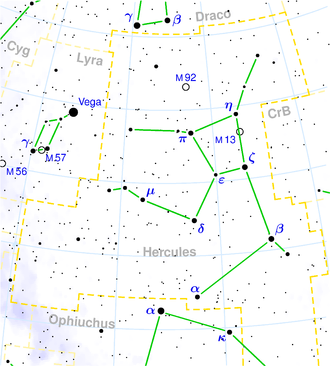Markaryan 501
| Galaxy Markaryan 501 |
|
|---|---|

|
|
| 2MASS image of the galaxy Markarjan 501 | |
| AladinLite | |
| Constellation | Hercules |
|
Position equinox : J2000.0 , epoch : J2000.0 |
|
| Right ascension | 16 h 53 m 52.2 s |
| declination | + 39 ° 45 ′ 37.0 ″ |
| Appearance | |
| Morphological type | E ?; BLLAC |
| Brightness (visual) | 13.8 mag |
| Brightness (B-band) | 14.5 mag |
| Angular expansion | 1.2 ′ × 1 ′ |
| Physical data | |
| Redshift | 0.033663 ± 0.000073 |
| Radial velocity | (10092 ± 22) km / s |
| distance | approx. 400 million ly |
| history | |
| Catalog names | |
| UGC 10599 • PGC 59214 • MCG + 07-35-002 • Mrk 501 • | |
Markarjan 501 (Mrk 501, also Mkn 501) is a blasar in the constellation Hercules , which was first systematically observed by Benjamin Markarjan . It is about 500 million light years (according to other sources only 300 million light years) away from Earth. At its center is a black hole with a mass of around 0.9 to 3.4 billion solar masses. The resulting jet beam has almost the speed of light and is directed towards earth.
Markarjan 501 belongs with Markarjan 421 to the closest and most powerful high-energy gamma ray sources. He has been systematically observed with HEGRA on La Palma since 1995 . In 1997, several high-energy bursts were recorded, the intensity of which ranged up to ten times that of the Crab Nebula .
Markarjan 501 is also an important object for the examination of new theoretical physical approaches. After Floyd Stecker found no evidence of non-constancy of the speed of light from the observation data in 2003, an outbreak was observed in July 2005 with the 17 meter MAGIC telescope on La Palma, in which photons in the teraelectron volt range were four minutes earlier according to previous evaluations arrived as photons with about 500 MeV. This is taken as an indication of the verifiability of quantum gravity . The FGST satellite launched in 2008 is intended to further improve these observations.
Individual evidence
- ↑ a b c d NASA / IPAC Extragalactic Database
- ↑ a b SIMBAD
- ↑ Again no references to the quantum foam of space-time on Wissenschaft.de, accessed on August 8, 2019
- ↑ Abstract: Investigation of quantum gravity through photons by Markarjan 501
